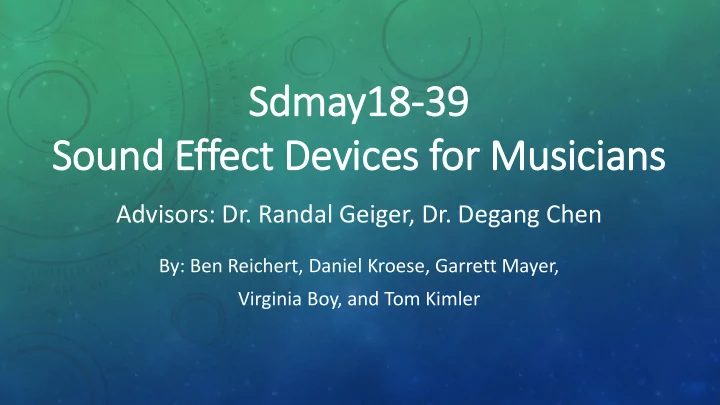

Sdmay18-39 39 Sound Effect Devices for Musicians Advisors: Dr. Randal Geiger, Dr. Degang Chen By: Ben Reichert, Daniel Kroese, Garrett Mayer, Virginia Boy, and Tom Kimler
OPPORTUNITY STATEMENT • Solid State Amplifiers • Tube Amplifiers • Pros • Pros • Inexpensive • Many prefer tonal qualities • Durable, easy to maintain • Cons • Power efficient • High initial cost • Cons • Expensive • Doesn’t produce tonal qualities that • Frequent maintenance most prefer • Heavy (bulky electronics) • Electrically inefficient • Warm-up time How can we achieve a tube-like audio profile without a tube amplifier? Furthermore, how can we enhance it? – The SuperTube Emulator
PROPOSED STRATEGY – SUPERTUBE EMULATOR • Emulator Benefits • Impose desired audio profile onto instrument signal • Allow user to control/personalize profile • Avoid pitfalls of tube amplification
BIG PICTURE – DESIGNING THE SUPERTUBE • We are a modeling SuperTube audio profile • Approach: 1. Research – What strategies are used to emulate vacuum tubes 2. Test/Analysis – Gather data and develop model parameters 3. Implementation – Construct emulator/enhancer that uses model parameters
[1] 1. RESEARCH • AES publications cite: • Total Harmonic Distortion (THD) • Dynamic Nonlinearities of Vacuum Tubes • Previous work: • Effects Pedals (Ibanez Tube Screamer) [2] • Software Modelling – Unidirectional, Linear Filtering These solutions are simply replications of the tube effect Research provides our first potential parameters for defining our system
2. TESTING – DERIVING OUR OWN PARAMETERS • Research lacks a closed-form algorithm for tube emulation… we need to observe these parameters in action • Data Acquisition Test Bench: • High-Resolution Data capture • Multi-Channel Recording allows for: • Synchronized data analysis • Channel-to-channel comparison
2. CHARACTERIZATION OF TONAL QUALITIES • Analysis Methods (MATLAB) • Time Domain • Frequency Domain • DFT • Spectrogram • Objectives • Identify nonlinear distortions, frequency distortions, etc… • Quantify Observations in Spectral Decays We have started to focus down on our model parameters
FUTURE – HOW DO WE IMPLEMENT THESE PARAMETERS? • Develop Profile • Algorithmically implement parameters • Optimize scheming to achieve SuperTube Effect • Implement Profile • Export profile to usable platform • Choose platform based on what yields best results • Evaluate Success • Subjective evaluation via human trials (musician and non-musician) • Objective evaluation via analysis tools
PROJECT MILESTONES AND SCHEDULE Project Timeline 1-Sep 2-Oct 2-Nov 3-Dec 3-Jan 3-Feb 6-Mar 6-Apr 7-May Tube Amplifier Parameter Research Tube Emulation Tube Emulator Prototype Hardware Controller Prototype Prototype Testing Integration of Controller & Tube Emulator UI Design Tube Emulator Revision/Optimization Integration of Emulator, Hardware, and UI Final Product Build
QUESTIONS?
REFERENCES • [1][2]
P.C. SOFTWARE SUPERTUBE PROFILE • Benefits: • Allows for ease of model tuning • P.C. provides excess of: • Computation Power, Memory • Instant Access to Analysis tools (e.g. Matlab) • High Throughput Effectively the fastest way to build a functioning Emulator • Build in C • Low Level Language – Portable to Hardware • FFTW Library Once a functioning Emulator is achieve – we optimize for Hardware (reduce latency, etc.)
MICROCONTROLLER- IMPLEMENTED EMULATOR • Provides more appealing final form factor: • Portable • Real-time (post algorithm optimization) • Easy to use • Tunable
Recommend
More recommend